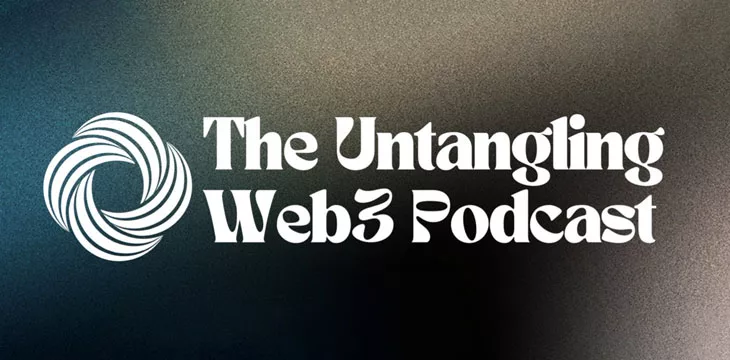|
Getting your Trinity Audio player ready...
|
The second episode of Untangling Web3 (UW3) with hosts Alec Burns and Jack Davies focused on blockchain technology, its history, major use cases, and core concepts. According to Burns and Davies, blockchain and Web3 are closely linked, and the content throughout this episode will help listeners understand why.
What is blockchain?
To kick things off, Burns shared his definition of blockchain, “a digital record of transactions that are shared and maintained by multiple computers.”
“This, along with some quite detailed mathematics and cryptography make it very secure and very difficult to edit and that’s the core concept of blockchain,” he added.
Davies said, in his opinion, there are two aspects that make up blockchain. One aspect is the data structure itself. The second aspect—and why “blockchain” has become such a buzzword—is the distributed ledger (vs. just a digital ledger), meaning the ledger is shared and replicated amongst a network of computers.
History of blockchain
Davies explained the advent of Bitcoin popularized blockchain in January 2009, Bitcoin being the most widely used application of this structure.
“Bitcoin is really the thing that kicked everything off and started the conversation about blockchain,” he said.
Burns added that Ethereum is the second biggest blockchain by market cap and was created with a “world computer” in mind, while Bitcoin was created as a peer-to-peer electronic cash system.
Fast forward to today, and there are literally 1000s of different blockchains.
The notion of why we have so many blockchains vs. just one or two was put forth by Davies. He explained how new blockchains have been started up to be application-specific, or companies have tried to launch their own as a fund-raising mechanism.
A third avenue is to have one blockchain where many people agree on what should be happening, and there is a broad consensus on how it should work.
Another category we have is private blockchains, but they are not used as much anymore, and people have gone back to public blockchains such as BSV and Ethereum. The pair pointed out how, back in the day, we had private internet, but people eventually went back to the public internet, a similar pattern to what we see in the blockchain world.
Burns added that one of the reasons why people or businesses may lean towards private blockchains vs. public is because there is a misconception about what a public blockchain means in terms of privacy. He said using a public blockchain does not mean your data is shared to everyone.
“You can just reference things on chain and its really difficult to create an actual link between the raw data and what’s being referenced on the blockchain,” Burns explained.
How does blockchain relate to Web3?
Seeing that this is a Web3 podcast, the hosts wanted to tie back their points about blockchain to the Web3 world.
“The initial ideas and principals that are inherent to blockchain, this idea of removing unnecessary third parties, having more efficient peer-to-peer direct interactions, all of these are values that are common to blockchain, essentially. They have co-existed and grown up together, this notion of web3,” said Davies of the relationship between blockchain and Web3.
“Web3 is a natural evolution of blockchain,” he confirmed.
Terms to untangle: decentralization
Decentralization is a word we so often hear thrown around when it comes to blockchain, but what does it mean, really?
“For something like Bitcoin, [decentralization means] the minimum number of parties you need for the network to maintain its properties,” said Davies
We need anywhere from 3 to 15 miners working on a chain to maintain immutability, function properly, etc. For these systems to function correctly, you don’t need a huge number of miners involved.
Burns said there are a lot of negative connotations associated with decentralization.
“Some people related it to a decentralization of power, but more and more a decentralized network is about a robust system which removes any single points of failure,” he explained.
Peer-to-peer
“Peer-to-peer,” a term used throughout the Bitcoin white paper and also within the Web3 world, refers to a direct exchange between users without unnecessary third parties, similar to how cash works.
The hosts discussed how there are inefficiencies the Bitcoin model can improve, such as in digital payments where there are so many fees and intermediaries involved.
Digital currency
Can we call Bitcoin “digital currency”? According to Burns and Davies, Bitcoin is more like digital money than currency.
Immutability
Immutability is one of the core aspects of blockchain, first when it comes to its decentralized nature and second with consensus. It is difficult, if not impossible, to change the records once they are in the ledger.
Use cases: Social media
Next, the hosts went into use cases for blockchain technology. Davies discussed how we can improve social media with blockchain by using micropayments.
For example, now its free to use social media and because there is no cost associated with abusing the system, trolls and bot farms abuse the system at leisure. Instead of being free, we can apply a certain (negligible) cost, so the system becomes costly to abuse at scale.
Burns added by infusing micropayment functionality with social media, we suddenly have new ways to monetize engagement.
Supply chain
Burns went on to highlight the supply chain as another classic, tangible use case for blockchain technology. He said consumers care if their product comes from fair trade, and we need trust in data. By using blockchain tech for supply chain data management, we can understand the various stages of the item we are buying, where it’s coming from, etc. We can be sure the data is accurate when blockchain is involved because it cannot be edited or changed.
“There is a lot of work going around digital identity and as soon as we start to combine that with the data that’s being submitted on-chain, we then get a degree of authenticity and probably, even the ability to verify that data as well,” Burns said.
Davies added that private blockchains were targeting this use case and asked Burns to explain how a public blockchain could be used for the supply chain while keeping sensitive information confidential.
To break it down into simple terms, Burns explained we could put the sensitive data through a hashing algorithm so it’s “muddled,” put it on the blockchain, and later on, if someone wants to check the data, they can. The raw data itself does not go on-chain. Only off-chain is where the raw data is exchanged.
Concerns with using blockchain: Scalability
According to Burns, scalability is a major pain point with many blockchains out there. Take CryptoKitties, for example (built on Ethereum), when the application took off, the fees were astronomical!
“This is a big issue for a lot of blockchains, the scalability aspect,” he confirmed.
Privacy
As we have touched on several times already, the privacy of data stored on a public blockchain is a concern for many. Davies explained what you can see on the blockchain is the public key, and you can build complex privacy features on top.
“You can sacrifice your privacy if you use it incorrectly,” he cautioned.
Security measures as an individual
When using blockchain technology, it can be difficult to recover funds if you are not familiar with how the system works. Take care of your 12-word phrase for wallet recovery, and don’t throw out your hard drive with your private keys!! (It has been done before and is now in a landfill with thousands of BTC involved).
It’s getting easier to recover funds as time goes on, but you still have to be careful because there are risks involved, the hosts advised.
Watch The Bitcoin Masterclasses: Workshop: Practical ways to use blockchain & IPv6

 06-16-2025
06-16-2025 





